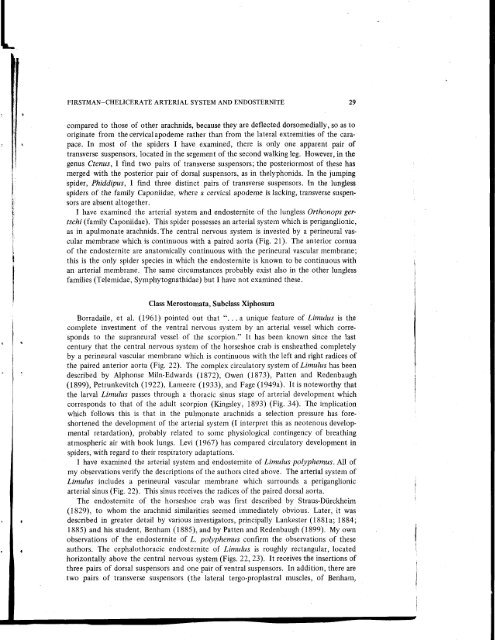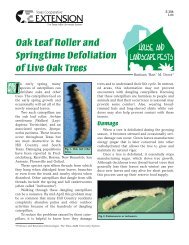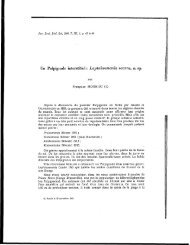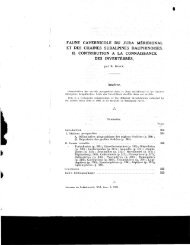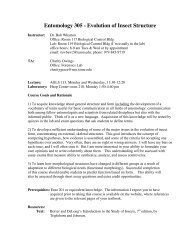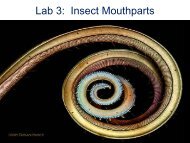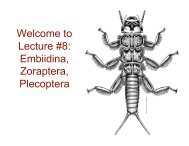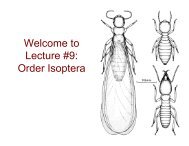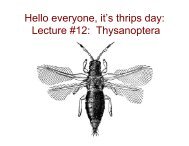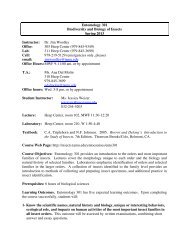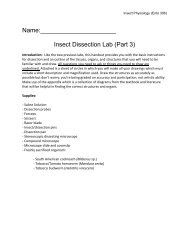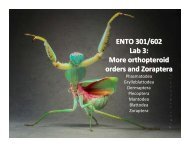THE RELATIONSHIP OF THE CHELICERATE ARTERIAL SYSTEM ...
THE RELATIONSHIP OF THE CHELICERATE ARTERIAL SYSTEM ...
THE RELATIONSHIP OF THE CHELICERATE ARTERIAL SYSTEM ...
You also want an ePaper? Increase the reach of your titles
YUMPU automatically turns print PDFs into web optimized ePapers that Google loves.
FIRSTMAN-<strong>CHELICERATE</strong> <strong>ARTERIAL</strong> <strong>SYSTEM</strong> AND ENDOSTERNITE 29compared to those of other arachnids, because they are deflected dorsomedially, so äs tooriginale from the cervical apodeme rather than from the lateral extremities of the carapace.In most of the spiders I have examined, there is only one apparent pair oftransverse suspensors, located in the segement of the second walking leg. However, in thegenus Ctenus, l find two pairs of transverse suspensors; the posteriormost of these hasmerged with the posterior pair of dorsal suspensors, äs in thelyphonids. In the jumpingspider, Phiddipus, I find three distinct pairs of transverse suspensors. In the lunglessspiders of the family Caponiidae, where a cervical apodeme is lacking, transverse suspensorsare absent altogether.I have examined the arterial System and endosternite of the lungless Orthonops gertschi(family Caponiidae). This spider possesses an arterial System which is periganglionic,äs in apulmonate arachnids. The central nervous System is invested by a perineural vascularmembrane which is continuous with a paired aorta (Fig. 21). The anterior cornuaof the endosternite are anatomically continuous with the perineural vascular membrane;this is the only spider species in which the endosternite is known to be continuous withan arterial membrane. The same circumstances probably exist also in the other lunglessfamilies (Telemidae, Symphytognathidae) but I have not examined these.Class Merostomata, Subclass XiphosuraBorradaile, et al. (1961) pointed out that "... a unique feature of Limulus is thecomplete Investment of the ventral nervous System by an arterial vessel which correspondsto the supraneural vessel of the scorpion." It has been known since the lastCentury that the central nervous System of the horseshoe crab is ensheathed completelyby a perineural vascular membrane which is continuous with the left and right radices ofthe paired anterior aorta (Fig. 22). The complex circulatory System of Limulus has beendescribed by Alphonse Miln-Edwards (1872), Owen (1873), Patten and Redenbaugh(1899), Petrunkevitch (1922), Lameere (1933), and Fage (1949a). It is noteworthy thatthe larval Limulus passes through a thoracic sinus stage of arterial development whichcorresponds to that of the adult scorpion (Kingsley, 1893) (Fig. 34). The implicationwhich follows this is that in the pulmonate arachnids a selection pressure has foreshortenedthe development of the arterial System (I Interpret this äs neotenous developmentalretardation), probably related to some physiologjcal contingency of breathingatmospheric air with book lungs. Levi (1967) has compared circulatory development inspiders, with regard to their respiratory adaptations.I have examined the arterial System and endosternite of Limulus polyphemus. All ofmy observations verify the descriptions of the authors cited above. The arterial System ofLimulus includes a perineural vascular membrane which surrounds a periganglionicarterial sinus (Fig. 22). This sinus receives the radices of the paired dorsal aorta.The endosternite of the horseshoe crab was first described by Straus-Dürckheim(1829), to whom the arachnid similarities seemed immediately obvious. Later, it wasdescribed in greater detail by various investigators, principally Lankester (1881a; 1884;1885) and his Student, Benham (1885), and by Patten and Redenbaugh (1899). My ownobservations of the endosternite of L. polyphemus confirm the observations of theseauthors. The cephalothoracic endosternite of Limulus is roughly rectangular, locatedhorizontally above the central nervous System (Figs. 22, 23). It receives the insertions ofthree pairs of dorsal suspensors and one pair of ventral suspensors. In addition, there aretwo pairs of transverse suspensors (the lateral tergo-proplastral muscles, of Benham,


